|
|
Introduction
In 2008 the Company developed the software for the Main Electrical Circuit Simulator of Yugres (South-Ural State Region Power Plant – Branch Company of OAO “OGK-3”). The Simulator is to be used for training of the operational personnel of Yugres. The Simulator was successfully commissioned with good assessment of the Customer.
Accuracy of the technology parameters simulation meets the requirements of “Standards for the Power Industry Staff Training Software” (RAO “Russia EES”, SÎ 153-34.0-12.305-99) and the Concern ROSENERGOATOM Standard “Technical Means of Training” SÒÎ 1.1.1.01.004.0680-2006.
Main features of the simulator
The Simulator represents generation, distribution and consumption of electrical energy through the Main Electrical Circuit of Yugres and provides the Main Control Room personnel training.
The area of simulation includes:
1. Generators ÒG2 - ÒG10.
2. Main transformers Ò2 - Ò10.
3. Auxiliary transformers (ÒSN2 – ÒSN8, ÒSN9À, ÒSN9B, ÒSN10À, ÒSN10B).
4. Reserve auxiliary transformers ÒSNR1 –ÒSNR3.
5. Section bus bars (SB-1, SB-2) 220/110/10/6.3/3 kV.
6. External system of infinite power.
7. Communication lines.
8. Switchs/breakers.
Models of the control systems, relay protection and automatics, as well as the other systems of the automatic control and protection, emergency and warning signaling, represent all main functions of the Yugres Main Electrical Circuit equipment noted above. The Simulator includes:
- More than 300 protections of generators, transformers, 220 kV and 110 kV bus bars, SRBD AS of 110 kV and 220 kV turbogenerators;
- More than 500 signals of WSS and ESS;
- More than 500 blinkers;
- ARS and auto-presentation of before-emergency mode of AL 220 and 110 kV, RAS 10, 6 and 3 kV, more than 40 in total;
- More than 480 blinkers;
- More than 700 patches and test units (TU).
All indicators placed in the real Main Control Room are simulated as well, more than 350 in total.
The Simulator represents operation of the Main Electrical Circuit in the following modes:
- Energizing of the distribution units of the Yugres under complete load dropping with auxiliary systems powering loss;
- Startup, synchronization and switching on of the power units into the system;
- Loading of the Yugres power units up to the set power level;
- Operation of the power unit at the intermediate power levels;
- Planned shutdown;
- Emergency shutdown.
The Simulator is designed using the special software developed by the Company’s specialists. (Äàòü ññûëêó íà ñîîòâ ðàçäåë ñàéòà).
Animation and information fields of the Simulator are realized at the computer displays using the special means of digital and graphic information presentation; these special means are capable to present the information with maximal similarity to the real control panels information.
Operator work station
Operator work station allows the trainees to watch the parameters and control the technology process.
Operator work station includes two graphic monitors of the same functions. The mouse cursor moves free at any monitor screen. Both monitor screens are provided with control panel and work field. The control panel is placed at the top of the screen with current date and the Simulator time at its left top corner.
The work field comprises the fragments (slides) called by operator with images of the control panels of the power station technology equipment. The fragments are specified as the main – fragments of virtual panels of MCR, and additional – fragments of virtual panels of RPA, fire board, left and right synchronizing elements.
The Simulator fragments represent completely and with maximal similarity every real 43 MCR panels, as wel as RPA panels conserned to the simulated equipment, 90 fragments in total.
The main and additional fragments of the operator work station are demonstrated below (Figures 1, 2, 3).
Figure 1. MCR main fragment “29U Panel”. At the top, as well at left and right parts of the fragment, the navigation buttons “Back”, “28U” and “30U” are placed. These navigation buttons allow to turn back to the fragment called before and to the fragments “28U Panel” and “30U Panel” correspondingly.
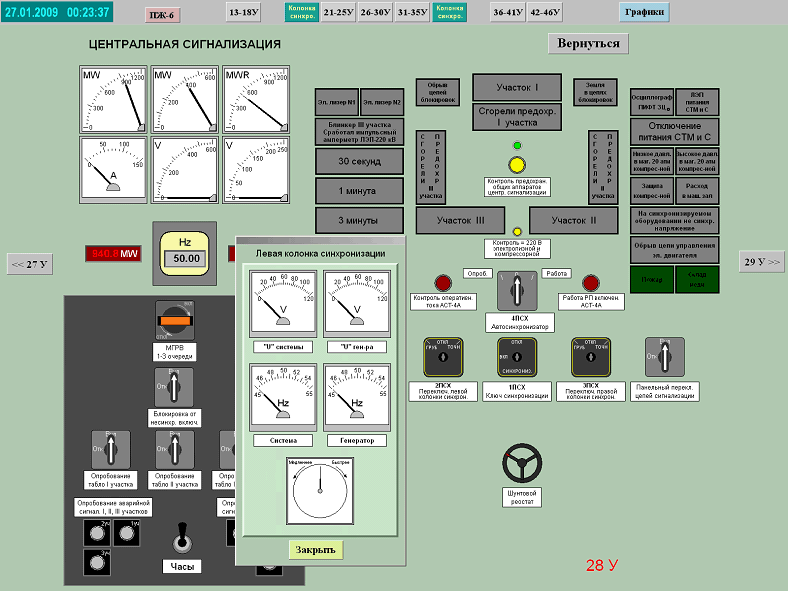
Figure 2. MCR main fragment “28U Panel”
and additional fragment “Left synchronizing element” placed over.
Figure 3. Additional fragment of “202 Panel”. The additional fragments are called by operator for the period of RPA circuits changeover and control of the blinkers state.
Instructor work station
Instructor work station, as the operator one, includes two graphic monitors. One of them called “Operator monitor” provide the instructor with access to the same functions and operations as the operator. Other monitor called “Instructor monitor” provide the instructor with control over the Simulator and training.
The screen of the instructor monitor includes:
- the Simulator control panel;
- work field;
- navigation panel.
The Simulator control panel AT THE INSTRUCTOR SCREEN is continuously available at the top of the screen as it is demonstrated below (Figure 4):
Figure 4. The Simulator control panel.
From this panel the instructor can switch on/off the Simulator, create training session, load and edit the session, start up training, review the protocols of events and trainee’s actions, look over the diagrams of the parameters change, start up the utility of assessment of trainee’s actions, archive the training results etc.
The instructor monitor work field occupies the most part of the screen; the instructor may call there the fragments of the virtual panels of technology equipment control. Animation of the equipment at the instructor fragments is realized as at the operator ones, i.e. the instructor can see at his fragments the state of equipment and values of the measured parameters. But the instructor cannot control technology equipment from his fragments, although it is possible to output malfunctions through special pop-up menu arising after click at the choused equipment.
From the fragment “Turbogenerator control” of instructor work station it is possible also to control the turbogenerators, see Figure 5.
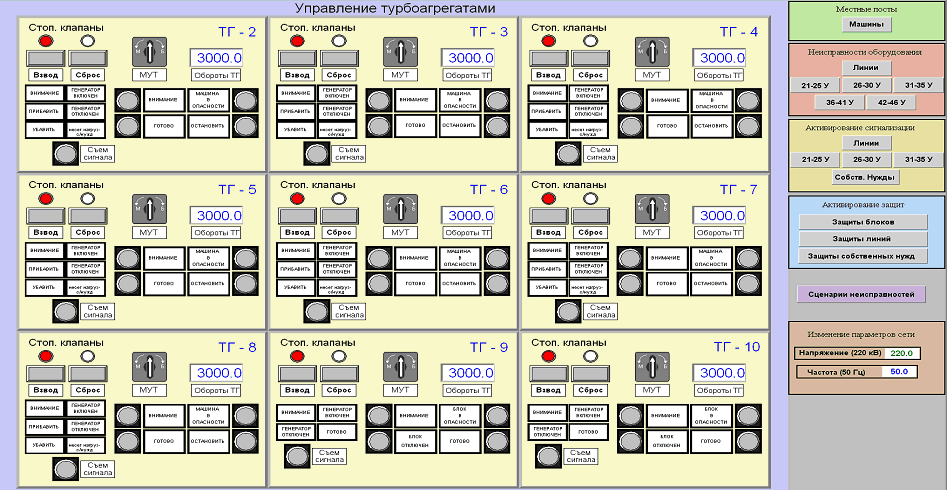
Figure 5. Instructor fragment “Turbogenerator control” and navigation panel.
Navigation panel is continuously available at the right part of the screen, see Figure 6.
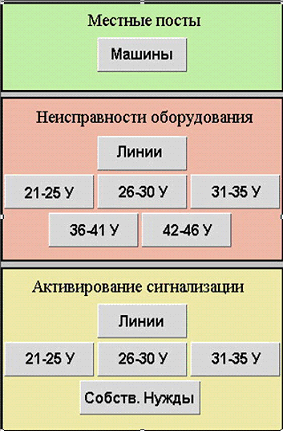 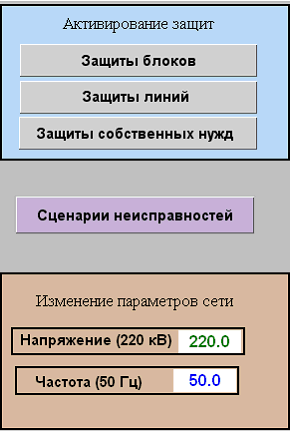
Figure 6. Navigation panel.
From the navigation panel instructor can call to the screen work field the following fragments:
- fragment of the turbogenerators control panels – “Machines”;
- fragments of the virtual panels of technology equipment control – “Equipment malfunctions”. From these fragments instructor can control state of technology equipment, their parameters and set malfunctions;
- fragments of activation (illumination) of emergency and warning signal system panel;
- fragments of protection and interlocking input (activation).
This panel also includes the button of calling to the screen tools of creation and edit of malfunction scenario and window for recording the outside system parameters.
The Simulator includes 16 instructor fragments in total. Part of the instructor fragment “Unit protection” is demonstrated below (Figure 7).
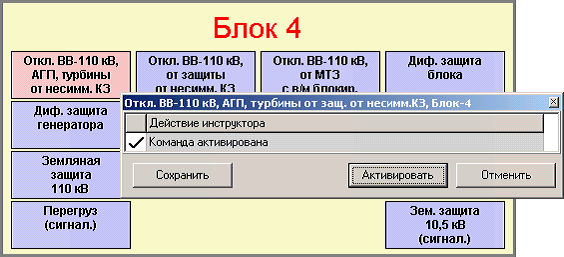
Figure 7. Setting of the Unit ¹4 protection by the instructor.
Assessment of trainee’s actions
The Simulator is provided with special service programs to assess trainee’s actions. The results of training as diagrams of parameters change and protocols of events and trainee’s actions are available for the instructor at the end of training; also it is possible automatically assess trainee’s actions taking into account his errors.
The simulator ATP
Full-scale acceptance testing of the Simulator was held at the Contractor’s site as well as commissioning at the Customer’s site according to ATP program approved by the Customer. The Customer’s operational and maintenance personnel was also trained to use the Simulator.
During ATP the Customer’s personnel noted that:
1. Physical model adequately presents the processes in the Main Electrical Circuit of Yugres.
2. Models of RPA and EA systems correctly and completely realize the algorithms of the Main Electrical Circuit equipment switching.
3. Models of MCR and RPA panels adequately present the real panels of Yugres.
4. The Simulator service programs are easy to use and improve the instructor’s abilities in training, notably:
· Control of the Simulator (start up, shutdown etc) does not need the instructor’s deep special knowledge;
· Training session is created as simple replay the training by the instructor and saving it as “Reference”;
· Output of the parameters diagrams lets the trainees to improve understanding of the physical processes in the Main Electrical Circuit;
· Output of the events and actions protocol lets the trainee to understand interconnection of his actions and current events; the instructor can well-reasoned debrief and evaluate trainee’s actions;
· The Simulator automatic system of trainee’s actions assessment lets to minimize time of training and teacher work.
The Simulator was success during ATP and commissioned at the Customer’s site.
The Company grants the Customer a one-year warranty service according to the remarks revealed by the Customer in frames of TR for the Simulator.
Abbreviations
AL – air line
ARS – automatic repeated switching on
AS – air switch
ATP – acceptance test procedure
EA – emergency automation
ESS – emergency signal system
MCR – main control room
RAS – reserve automatic switching on
RPA – relay protection and automation
SRBD – switch reserve break device
ÒG – turbogenerator
TR – technical requirements
WSS – warning signal system
|